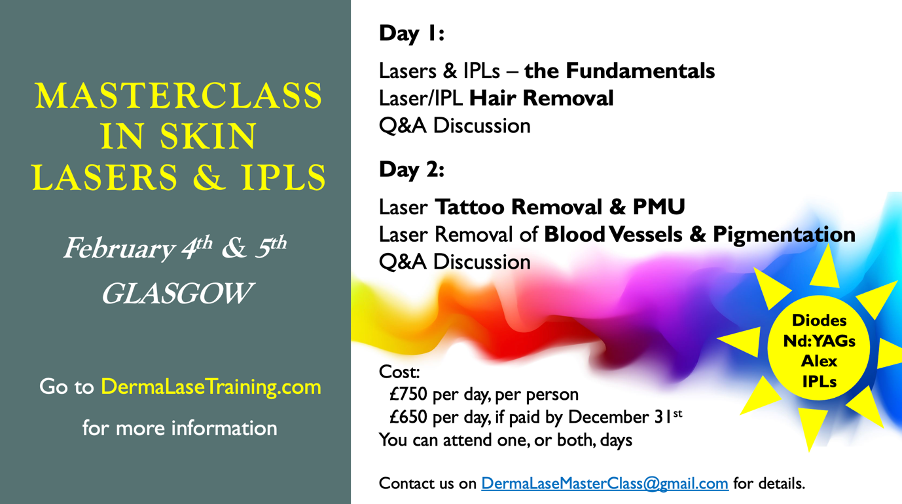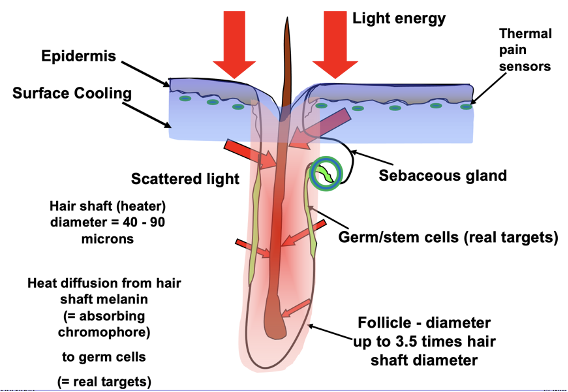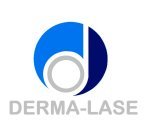Laser/IPL hair removal can be ‘tricky’. There are a number of issues to be consider including hair colour and depth, skin colour, hair growth cycle, body area, fluence, pulsewidth etc etc etc…
My calculations show that the ‘standard’ efficiency, when trying to kill hair follicles, out there is typically between 50 and 60%. In other words, only around 50 to 60% of the anagen hair follicles treated are actually destroyed in any one treatment session. This is not particularly good…
How can we improve this?
Here are my thoughts:
| Fluence | Absolutely critical!!! Fluence is directly and linearly linked to the temperature rise in the absorbing targets. More fluence means higher temperatures. If the fluence is too low, only some of the target germ cells will die, leaving behind a smaller quantity. During the next anagen phase, this smaller quantity will, inevitably, generate a smaller, finer follicle with a thinner hair containing less melanin – which is harder to kill!! Fluence is directly linked to the depth of the follicles. Deeper follicles, such as found in the bikini and underarms, require higher fluences since many of them are typically located deep in the dermis. In all cases, the appropriate fluence should be applied from the very first treatment session – increasing the fluence at each subsequent session is not a good approach! This method will inevitably result in regrowth of finer hairs. Most importantly, the choice of fluence is determined by the hair colour and depth – always treat ‘dark’ hairs. Lighter hairs simply do not contain enough melanin! Do NOT set your fluence according to the skin colour (or ‘Fitzpatrick’) – that is a mistake (see ‘Skin Cooling’ below)!!! So, increasing the fluence will ALWAYS improve the killing efficiency of follicles. Definition of fluence: Fluence is the concentration of energy into an area. We take the energy delivered to the skin surface and divide it by the area it is delivered into. So, if 10 Joules of energy is delivered into a 2 cm2 spot area, then the fluence is just 10 / 2 = 5 J/cm2. |
| Pulsewidth | Also known as pulse length and pulse duration – they are all the same!! The pulsewidth of a laser or IPL pulse of energy is merely its duration – or, how quickly or slowly the light energy is delivered. This directly affects the final, maximum temperatures achieved in the targeted hairs. A short pulsewidth means that there is not much time for the heat energy to diffuse from the absorbing target, while the pulse is still happening. This induces a high peak temperature in that target, since the heat energy is ‘localised’ there. A longer pulsewidth will allow more heat energy to ‘escape’ from the target while the light energy is still being delivered. This means that the target will not reach the same peak temperature as with a short pulsewidth. Many people set their pulsewidth according to the thickness of the target hairs. While there is some merit in this (which I am investigating with my newest computer model), the fact is that the choice of fluence is much more important – for thick and thin hairs! |
| Gaps between sessions | All hairs grow according to a cycle – ‘anagen, catagen, telogen’. Light-based therapies only appear to kill follicles in part of the anagen phase (not the whole phase!!). The variation in the duration of anagen and telogen phases is very large – from weeks to years. The optimum time to treat follicles is when the maximum number of those follicles is in the anagen phase. If treatment gaps are too short, only a small number of anagen follicles will be presented for treatment. Computer modelling clearly shows that leaving longer gaps between sessions will result in fewer session being required to kill all the follicles. |
| Skin cooling | Skin cooling is critical!! Pre-cooling the skin will reduce pain, the likelihood of blistering, hyperpigmentation and upper skin damage. It also allows for higher fluences to be applied since the upper layers of the skin are colder than usual. Darker skin tones contain higher concentrations of melanin – this is, essentially, a barrier to the dermis. That melanin ‘steals’ some of the incoming light energy and generates heat in the epidermal basal layer. This indicates that more pre-cooling is essential in darker skins. It also indicates that higher fluences are required to ensure a sufficient amount of energy reaches the follicles. Most of the pain associated with laser/IPL hair removal comes from the thermal pain receptors which lie just below the basal layer. Cooling these receptors before applying the light energy will significantly reduce pain. Obviously, darker skins will require more pre-cooling – perhaps up to 5 minutes using ice-packs. However, the hairs cannot be over-cooled, before treatment. They will always absorb more light energy than the basal layer, due to their higher concentration of melanin. Less than 10% of the light energy applied to the skin surface actually reaches the melanin in the hair shafts. This means that most of the energy is either expelled from the skin via back-scattering, or remains in the skin, looking to ‘cook’ some other tissues. So we MUST extract that excess heat energy from the skin as quickly as possible, before it creates unwanted tissue damage. Ice-packs applied for a few minutes after a treatment are a good idea. Don’t allow your patient/client to leave until their skin feels cold to the touch. The amount of skin cooling is determined by the skin colour – NOT the Fitzpatrick (that is entirely irrelevant in these treatments). The darker the skin tone, the more pre- and post-cooling should be applied. Using proper skin-cooling will improve the overall efficiency of these treatments by reducing the level of unwanted skin damage. We are deliberately trying to “burn” something in these treatments – the follicles, in this case – so we must mitigate this deliberate burning with deliberate cooling. This is very important! |
| Consistent placement | Many laser operators do not appear to be consistent when placing their laser/IPL handpiece tips on the skin. They map out a fairly haphazard pattern of shots on the skin surface. This is very poor as it will only be effective on some follicles, whilst leaving others untouched. Adopt a more consistent approach by carefully placing shots – either by stamping or using the SHR technique (see below) – such that there are no ‘gaps’ in the treatment area. |
| Technique | With all current lasers and IPLs, a choice of application techniques is available. “Stamping” – with this technique you apply one shot of a relatively high fluence to each area. The fluence is selected to ensure complete destruction of the follicles, which depends on their depths – one shot of this fluence should be sufficient to induce the required damage. Good pre- and post-cooling is essential with this technique, to minimise any unwanted tissue damage. If using the stamping technique, do NOT overlap the shots. “SHR” – also known as ‘in motion’ or ‘gliding’ method. This technique is often applied poorly, according to many online videos I’ve seen. It must be correctly applied to relatively small areas to be efficient. I recommend using it in 10 x 10 square cm areas. The point of this technique is to slowly build up the heat energy in this area, to a point where the temperatures are sufficient to kill the follicles. This requires that the correct amount of total energy is applied to the skin. The total energy is equal to the fluence (J/cm2) times the laser/IPL spot size area (cm2) times the repetition rate (number of shots per second, Hz) times the number of passes in each strip. Some devices show this value on the screen – others don’t! Both techniques are equally good, if applied correctly. Using them properly, will increase the overall efficiency by ensuring more follicles are treated in each session. |
| Wavelength | Melanin absorbs light energy across the whole of the visible spectrum and into the near infra-red spectrum. This means that many lasers and IPLs may be utilised to target that tissue. However, the absorption coefficient of melanin falls as wavelength increases. This means that shorter wavelengths, such as the alexandrite laser at 755nm, are absorbed more strongly than longer wavelengths (like the Nd:YAG at 1064nm). This also means that more of the shorter wavelengths will be absorbed in hairs for the same applied fluence – for example, alexandrite light energy is absorbed more by a factor of almost 2.45 times compared with the Nd:YAG wavelength. This leads to higher temperatures in hairs treated with alexandrite lasers, compared with all the other technologies currently available. It also indicates that higher fluences are required as the wavelength increases too (Nd:YAG fluence must be significantly higher than alexandrite fluences to achieve the same goal)! But, we also need to consider that longer wavelengths also penetrate deeper into the skin than shorter ones. This means that 1064nm can reach deeper follicles more readily than the alexandrite wavelength. In addition, the alexandrite 755nm wavelength is also more strongly absorbed in the epidermis too – leading to more potential thermal damage there. This suggests that more cooling is required for shorter wavelengths! Some people say that alexandrite lasers and IPLs can only be used on skin types 1, 2 and 3. This displays a lack of understanding of the heating process in the epidermis. All wavelengths can be used on all skin tones – it is simply that the amount of cooling must also be carefully considered. Darker skins always require more pre-cooling, especially with shorter wavelengths like alexandrite. However, black skin is much more likely to be damaged with shorter wavelengths since it can be very difficult to cool it sufficiently. I recommend that only the Nd:YAG laser be used on black skin, to minimise any unwanted damage. Choosing the most appropriate wavelength will also help to increase the efficiency. |
| Calibration | It is very important to keep your laser/IPL equipment calibrated. If not, how can you know what the actual fluence is being applied? All lasers and IPLs will lose energy over time and usage. The more heavily a device is used, the faster its output energy will degenerate. Regular calibrations will ensure you are delivering the proper amount of fluence every time. |
All of the above suggestions will help to push up your overall clinical efficiency, and help to improve results. There may be other ideas which help – I’d love to hear them…
Even if you achieve an increase of only 10% in efficiency, you will notice better treatment results and fewer treatment sessions with your patients/clients.
The main points to consider here are that:
Fluence is dictated by the hair colour and depth,
Pre-cooling is dictated by the skin colour,
The gaps between sessions is important.
Hope this helps,
Mike.
PS Our next MasterClass will be held in Glasgow in February 2024. If you are interested in attending, please contact Lisa on lisa.dermalase@gmail.com for more details.




This is fantastic advice! I own a candela GentleMax Pro laser, and have run a small medical spa in Canada for 6 years. We were taught to use the default parameters in all treatments and to book appointments every 4 to 6 weeks. Could you please provide some parameters as guidelines?
Hi. I’ve only just seen this comment. I trained some ladies in New York last month on their GentleMax Pro. They were delighted with my techniques. Perhaps you might consider my Zoom training?
Mike.
Hi Mike ,
I would love to do some more training with you but my last few emails haven’t been answered . I’m wondering how best to get in touch ?
Amanda